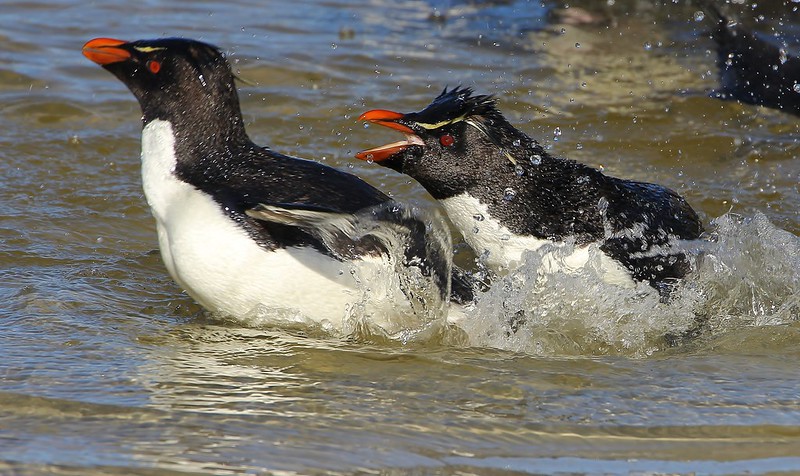By Rebecca Fox on Thu, 31 Oct 2013

Jim, a 20-year-old yellow-eyed penguin survived last year's
mortality event to return to his birth place at a Penguin
Place beach on Otago Peninsula to breed. Photo by Gerard
O'Brien.
The impact of last summer's mass mortality of yellow-eyed
penguins is starting to be felt, with a significant reduction
in the number of adults nesting on Otago Peninsula beaches.
With the penguins' breeding season just under way, only half
the nests normally found had been recorded on some of the
peninsula's popular breeding sites.
The reduction is believed to be a direct result of the mass
mortality event that killed 60 adult penguins on the
peninsula last season.
The cause of the deaths is still unknown, despite autopsies
and extensive toxicology testing.
Yellow-eyed Penguin Trust general manager Sue Murray said
estimated minimum breeding pairs for the trust's three sites
on Otago Peninsula had dropped from 15 to five in one site,
20 to eight in another, and eight to four in the other.
Many of those killed last season were adult breeders so some
impact on this season was expected.
Doc ranger Mel Young said until other nest counts on
peninsula beaches were completed, the true impact of the
mortality event would not be known. Many of the small
breeding sites checked were showing only half the number of
nests compared with last year.
On the positive front, one of the larger sites had 25 nests,
up from 21 last year, with many young birds nesting for the
first time, she said.
''A lot of these new birds have laid two eggs. There are very
few one-egg nests, which is unusual.''
However, it would not be known for another three weeks
whether these eggs were fertile and if the new parents could
keep both chicks alive.
''The younger birds' reproductive success is not the same as
15-year-old birds.''
There were many juvenile birds around which had survived
their first season at sea in good condition and many
''unemployed'' birds that were not nesting this season.
''That often happens after a bad year.''
The situation meant the public needed to be even more careful
on breeding beaches this summer, especially with dogs, she
said.
''Yellow-eyed penguins are very sensitive to human
disturbance.''
They needed to be able to come and go from the sea to their
nests to feed their chicks unencumbered.
''From when they hatch mid-November, it's critical.''
Penguin Place's Glen Riley said its beaches on the peninsula
had not been hit as hard by the mortality event as the
trust's, but it had still noticed a decline in nest numbers.
''It's bloody hard. It'll take a long time to recover after
this.''
At one of its beaches, there were only four nests, compared
with seven last year, and its main beach was down one to 12.
One breeding female was in its ''penguin hospital'' after
washing up on the beach underweight and was now being treated
with antibiotics.
''It's unusual to have her there, so we hope its not what's
to come.''
The first chicks of the season were due to hatch next week
while the next round were not due for a couple of weeks.
In 1990, 150 breeding adults died in unexplained deaths.
In the breeding season of 1990-91 only an estimated 150 pairs
were left in the South Island, but the number of pairs had
increased to 442 by 2012.
University of Otago scientist Dr Phil Seddon said there were
many unknowns about the drop in nesting numbers but any drop
was a concern.
''We have seen drops like this in the past and they have been
followed by a rebound. So, we remain hopeful that will be the
case this time.''
Much depended upon how many of the older, experienced animals
survived.
A student project would be investigating which penguins had
survived and if it related to their age and breeding history,
he said.
It was thought there were ''super breeder'' penguins that
were long-lived, bred every year and with a high level of
success, he said. Their offspring were also thought to be
keeping other colonies alive.
''They are very important.''
Tourism Dunedin chief executive Hamish Saxton said events
such as the mass mortality highlighted the importance of
protecting the penguins that were vital to parts of the
Dunedin economy.
Dunedin's reputation as an eco-tourism destination was partly
based on the yellow-eyed penguin and its rarity, so it was
enormously important to those business based on showcasing it
and other species, he said.
Five years ago, Australian economist Prof Clem Tisdell, of
the University of Queensland, calculated that nature-based
tourism relying primarily on the yellow-eyed penguin returned
$100 million annually to the Dunedin economy, with a single
breeding pair of yellow-eyed penguins valued at $60,000.
Otago Peninsula yellow-eyed penguins
• 67 died in last summer's mass mortality.
• Cause still unknown.
• Nest numbers more than halved in some places this
season.
• Yellow-eyed Penguin Trust colonies hit hard.
• Nesting in North Otago and the Catlins on par with last
year.
source







 King Penguins on the beach at Volunteer Point in East Falkland
King Penguins on the beach at Volunteer Point in East Falkland 















































































